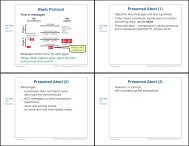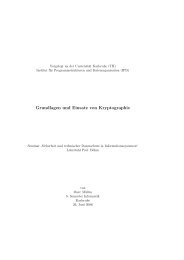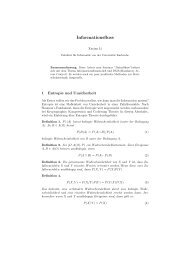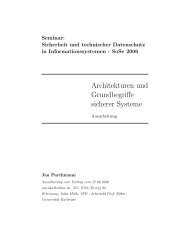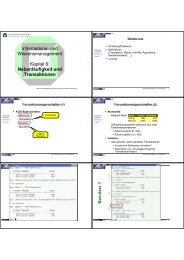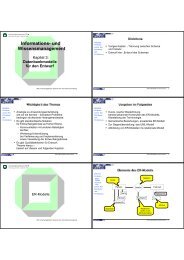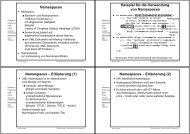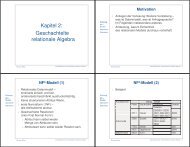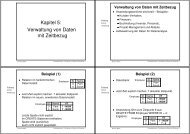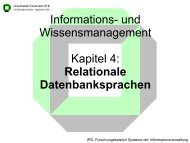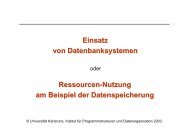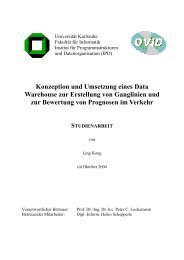View - Institute for Program Structures and Data Organization
View - Institute for Program Structures and Data Organization
View - Institute for Program Structures and Data Organization
You also want an ePaper? Increase the reach of your titles
YUMPU automatically turns print PDFs into web optimized ePapers that Google loves.
Stepwise Refinable Service Descriptions:<br />
Adapting DAML-S to Staged Service Trading ⋆<br />
Michael Klein, Birgitta König-Ries, <strong>and</strong> Philipp Obreiter<br />
<strong>Institute</strong> <strong>for</strong> <strong>Program</strong> <strong>Structures</strong> <strong>and</strong> <strong>Data</strong> <strong>Organization</strong><br />
Universität Karlsruhe<br />
D-76128 Karlsruhe, Germany<br />
{kleinm,koenig,obreiter}@ipd.uni-karlsruhe.de<br />
http://www.ipd.uni-karlsruhe.de/DIANE/en<br />
Abstract. In order <strong>for</strong> service-oriented architectures to become successful,<br />
powerful mechanisms are needed that allow service requestors to find<br />
service offerers that are able to provide the services they need. Typically,<br />
this service trading needs to be executed in several stages as the offer descriptions<br />
are not complete in most cases <strong>and</strong> different parameters have<br />
to be supplemented by the service requestor <strong>and</strong> offerer alternately. Un<strong>for</strong>tunately,<br />
existing service description languages (like DAML-S) treat<br />
service discovery as a one shot activity rather than as a process <strong>and</strong><br />
accordingly do not support this stepwise refinement. There<strong>for</strong>e, in this<br />
paper, we introduce the concept of partially instantiated service descriptions<br />
containing different types of variables which are instantiated successively,<br />
thereby mirroring the progress in a trading process. Moreover,<br />
we present possibilities how to integrate these concepts into DAML-S<br />
syntactically.<br />
1 Introduction<br />
In distributed environments, services offer an important possibility to enable<br />
cooperation among the participating devices. On the one h<strong>and</strong>, members can<br />
offer their resources as services <strong>and</strong> on the other h<strong>and</strong>, they can use the functionalities<br />
offered by other members in order to enable complex applications.<br />
When regarding typical distributed service-oriented systems like internet-based<br />
web services or services in peer-to-peer or ad hoc networks, we notice what they<br />
have in common is the fact that the participating devices are loosely coupled,<br />
only. In these environments, like on a public marketplace, services are traded, i.e.<br />
service offerers publish a description of their service, which are in turn searched<br />
by potential service users.<br />
At first glance, this trading seems to be comparable to “normal” internet<br />
searches, e.g., <strong>for</strong> certain documents. However, when one takes a closer look, it<br />
becomes obvious that indeed this is not the case. Typically, service offers are<br />
⋆ This work is partially funded by the German Research Community (DFG) in context<br />
of the priority program (SPP) no. 1140.
not fixed descriptions of all execution details, but contain different categories<br />
of variables which have to be instantiated in subsequent steps of the service<br />
negotiation be<strong>for</strong>e the service can be executed properly. Consider, e.g., a printing<br />
service: The description has to be made in a generic way, i.e. leaving space <strong>for</strong><br />
a user to specify the resolution <strong>and</strong> color type of the printout as well as the<br />
document he wants to have printed. Moreover, the service offerer cannot provide<br />
quality of service parameters like the time when printing will finish without<br />
knowing the size <strong>and</strong> <strong>for</strong>mat of the document 1 .<br />
Un<strong>for</strong>tunately, existing service description languages do not support incomplete<br />
service descriptions which can be successively completed in further steps.<br />
There<strong>for</strong>e, in this paper, we present a novel approach to service trading which<br />
takes into consideration that service trading is an interactive process rather than<br />
a one-shot activity. The approach is mainly based on DAML-S [1] <strong>and</strong> additional<br />
service ontologies that have been developed in our research project DIANE (see<br />
[2, 3]).<br />
In Section 2, we will first analyze existing service description languages <strong>and</strong><br />
shoe that most of them are not capable of accurately describing a configurable<br />
service. There<strong>for</strong>e, we will examine typical stages of service trading in Section<br />
3 using the printer example from above. Based on these deliberations, we will<br />
derive a generic state oriented service description language which describes the<br />
initial <strong>and</strong> resulting state of the service including fixed <strong>and</strong> variable parts. Each<br />
of these variable parts is expressed by a variable of a certain category exactly<br />
defining who has to instantiate it <strong>and</strong> when. It will turn out that the variables will<br />
not always be freely instantiatable <strong>and</strong> independent of one another. There<strong>for</strong>e, we<br />
<strong>for</strong>malize instantiation restrictions <strong>for</strong> these variables in a next step in Section 4.<br />
Finally, in Section 5, we show how the approach could be integrated into DAML-<br />
S using a special valueless RDF construct. The papers ends with a conclusion<br />
<strong>and</strong> an outlook to future work in Section 6.<br />
2 Related Work<br />
In this section, we want to examine existing service description languages. Besides<br />
languages that are explicitly denoted to describe services, we also want<br />
to take a look at languages to describe methods <strong>and</strong> operation of components<br />
in a middleware environment (sometimes also called component description languages).<br />
Typically, these component services have a finer granularity than common<br />
web services, are often developed <strong>for</strong> a non-human use, <strong>and</strong> seldom implement<br />
a self-contained action (see [4]). In the following, we will refer to these<br />
component operations as services, too, <strong>and</strong> also denote their descriptions as service<br />
descriptions.<br />
The most frequently used languages are message oriented service description<br />
languages. They try to describe a service by explaining the values<br />
that are entering <strong>and</strong> leaving the black box service (see Figure 1a). If the service<br />
is realized by methods of an object, this can be achieved by exporting the<br />
1 We will take a more detailed look at this printer example in Section 3.2.
a) message oriented<br />
incoming messages<br />
Service<br />
outgoing messages<br />
b) state/message oriented<br />
incoming messages<br />
initial state<br />
Service<br />
outgoing messages<br />
resulting state<br />
c) state oriented<br />
initial state<br />
placeholders<br />
Service<br />
placeholders<br />
resulting state<br />
Fig. 1. Different types of service description languages: (a) Message oriented languages<br />
try to describe services by their incoming <strong>and</strong> outgoing data, (b) state/message oriented<br />
languages additionally express the functional semantics by describing the initial <strong>and</strong><br />
resulting state, whereas (c) purely state oriented languages also omit the messages in<br />
favor of configurable placeholders in the state description.<br />
interface of the class, which defines the ingoing method parameters as well as<br />
the outgoing method result. Well known interface definition languages (IDL) are<br />
used in CORBA (as OMG IDL [5] or Java IDL [6]), Microsoft’s RPC, COM <strong>and</strong><br />
DCOM (as Microsoft IDL or MIDL [7]), in the area of web services (as Web IDL<br />
[8]) <strong>and</strong> also Java RMI [9], Jini [10] or Enterprise Java Beans [11] (as st<strong>and</strong>ard<br />
Java interfaces). On the other h<strong>and</strong>, languages like WSDL [12], e-Speak (used<br />
within Hewlett Packard’s Web Services Plat<strong>for</strong>m [13]), the Collaboration Protocol<br />
Profile from ebXML [14] <strong>and</strong> IBM’s Network Accessible Service Specification<br />
Language (NASSL) [15] more clearly point out the messages that enter <strong>and</strong> leave<br />
the service.<br />
However, these message centered description languages suffer from one severe<br />
drawback: The semantics of the service is left open, i.e. the description leaves<br />
unspecified how inputs <strong>and</strong> outputs are connected <strong>and</strong> what side effects are<br />
per<strong>for</strong>med. This functional semantics can only be guessed by a human user from<br />
the operation’s name or a textual description. Because of their severe problems<br />
with respect to automatic service trading, we will not consider these languages<br />
any further.<br />
This drawback is removed in state/message oriented service description<br />
languages. In addition to the flow of in<strong>for</strong>mation, they try to capture the<br />
functional semantics by describing the state of the world be<strong>for</strong>e <strong>and</strong> after suc-
cessful service execution (see Figure 1b). This can be achieved by the use of state<br />
ontologies like in DAML-S [1] (with extensions from [3]), OWL-S [16], <strong>and</strong> the<br />
Interagent Communication Language (ICL) from the Open Agent Architecture<br />
[17].<br />
However, this mixed description consisting of message parts <strong>and</strong> state parts is<br />
problematic: First, the influence of the parameters stemming from the exchanged<br />
messages on the involved states is left open <strong>and</strong> there<strong>for</strong>e unclear 2 . Second, it is<br />
unclear when the messages between service requestor <strong>and</strong> executor have to be<br />
sent. Generally, the problem arises from the fact that in these descriptions the<br />
abstract service representation is intermixed with a concrete execution realization<br />
(i.e. by sending messages). On the other h<strong>and</strong>, the necessary description of<br />
the variable parts of the state is removed from their description <strong>and</strong> can only be<br />
guessed in the description of the exchanged messages. Other approaches try to<br />
capture the transition of states more accurately with the help of high level logical<br />
programming languages like Golog [18] or Abstract State Machines [19]. However,<br />
this leads to an non-declarative, but imperative description of the service<br />
action, which prevents a useful comparison with a service request.<br />
As a consequence, the description of messages should be avoided in service<br />
description all together, which leads to purely state oriented service description<br />
languages. Here, the description of the states contains fixed parts,<br />
i.e. parts that are completely defined be<strong>for</strong>e service trading starts, as well as variable<br />
parts, i.e. placeholders which represent values that have to be negotiated<br />
be<strong>for</strong>e service execution can start (see Figure 1c). Similar ideas are included in<br />
LARKS [20], a language to describe agent capabilities. However, the process of<br />
correctly filling these values remains unclear. It turns out that each placeholder<br />
should be tagged with a label denoting by whom, when <strong>and</strong> how it should be<br />
filled in order to more clearly specify the process that is necessary to configure<br />
<strong>and</strong> execute this service. Nevertheless, the technical details of this configuration<br />
process (like the <strong>for</strong>mat of exchanged messages etc.) should be left open as they<br />
can be derived from the placeholders automatically. As the goal of this paper<br />
is to find a service description language <strong>for</strong> staged service trading, we will introduce<br />
a generic state oriented service description language by introducing the<br />
concept of states that are configurable with the help of variables <strong>and</strong> show how<br />
these ideas could be syntactically included into DAML-S.<br />
3 The Process<br />
As pointed out above, in contrast to simple internet or in<strong>for</strong>mation retrieval<br />
searches, service trading is a complex, interactive process. In this section, we<br />
take a closer look at this process, its different stages, <strong>and</strong> their respective requirements.<br />
2 In DAML-S/OWL-S, these connections have to be explicitly listed in a separat part<br />
of the description, the so called Service Model, which normally is not taken into<br />
consideration when matching services within the phase of service trading.
3.1 General Trading Process <strong>and</strong> Variable Categories<br />
In order to use a service in a loosely coupled, distributed environment, services<br />
have to be explicitly announced by their offerer (Stage 1). After that, from a<br />
client’s point of view, the following three phases (consisting of six stages) can be<br />
noticed:<br />
Phase I – Search<br />
Sending a service request (Stage 2) <strong>and</strong> gathering service advertisements<br />
(Stage 3).<br />
Phase II – Estimate<br />
Requesting (Stage 4) <strong>and</strong> comparing estimates (Stage 5).<br />
Phase III – Execution<br />
Choosing a service (Stage 6) <strong>and</strong> receiving its results (Stage 7).<br />
Typically, the service advertisements gathered in Phase I are not yet complete<br />
as different kinds of parameters are still missing. There<strong>for</strong>e, in Phases II <strong>and</strong> III,<br />
the advertisements are successively specialized by instantiating these variables.<br />
We denote variables that are used within Phase II estimate variables <strong>and</strong> mark<br />
them with index e. Variables used in Phase III are called execution variables <strong>and</strong><br />
are marked with an x. Furthermore, we distinguish variables based on the party<br />
that has to instantiate it. Variables that need to be instantiated by the client are<br />
called IN variables, the ones that are instantiated by the server are called OUT<br />
variables. To sum up, we differentiate between four categories of variables: IN e ,<br />
OUT e , IN x , <strong>and</strong> OUT x . Consider as an example the printing service mentioned in<br />
the introduction. IN variables could be the document identifier <strong>and</strong> the desired<br />
resolution. While the latter needs to be specified during Phase II to allow <strong>for</strong> e.g.<br />
cost estimates, it is sufficient to provide the <strong>for</strong>mer in time <strong>for</strong> service execution,<br />
that is in Phase III. Examples <strong>for</strong> OUT variables are the printer location <strong>and</strong> the<br />
estimated completion time. Again, the latter needs to be instantiated <strong>for</strong> Phase<br />
II, the <strong>for</strong>mer is known at execution time, only.<br />
3.2 Details of the Process<br />
With the help of the variables introduced above, we can now take a more detailed<br />
look at the process of service usage. As identified above, we have seven<br />
stages:<br />
(1) Service Announcement<br />
Whenever a device wishes to make a service available to other members of the<br />
network, it needs to provide a service advertisement describing the service it is<br />
willing to offer. This service advertisement has then to be made known to potential<br />
service requestors. This is done by some kind of service discovery mechanism<br />
<strong>and</strong> is outside of the scope of this paper (see [21] <strong>for</strong> an overview). In [3], we<br />
have described a process <strong>and</strong> a tool to develop such service descriptions. In order<br />
<strong>for</strong> service descriptions to be of any use in a loosely coupled environment, an
daml-s<br />
myPrintingService<br />
: Service<br />
diane<br />
<br />
: ColorType<br />
IN e<br />
diane<br />
QualityType<br />
IN e<br />
diane<br />
ResType<br />
presents<br />
color<br />
quality<br />
resolution<br />
diane<br />
: Locally Available<br />
diane<br />
precondition effect diane<br />
thePrintingProfile<br />
: Printed<br />
: In<strong>for</strong>mationServiceProfile<br />
time<br />
location<br />
entity<br />
entity<br />
diane<br />
doc : Document<br />
OUT x diane<br />
PrinterLocation<br />
dc:<strong>for</strong>mat<br />
filesize<br />
dc:identifier<br />
diane<br />
<br />
: FormatType<br />
IN e<br />
xsd<br />
Integer<br />
IN x<br />
xsd<br />
String<br />
OUT e daml<br />
Time<br />
Fig. 2. Advertisement <strong>for</strong> a printing service.<br />
ontology based approach is needed. In our approach, we distinguish three layers<br />
of service description. The top-layer contains the general structure of service<br />
descriptions. An example <strong>for</strong> such a top layer description is a modified DAML-<br />
S profile. Here, services are described by the initial states (preconditions) <strong>and</strong><br />
the resulting states (effects). The middle layer specializes these general state<br />
descriptions <strong>for</strong> different service categories, e.g., in<strong>for</strong>mation services, shopping<br />
services <strong>and</strong> so on. The specialization is achieved by restricting the types <strong>and</strong><br />
cardinalities of the service’s states. Finally, the third layer contains a collection<br />
of domain ontologies. A concrete service description is an instantiation of these<br />
three layers using one service category <strong>and</strong> one or more domain ontologies. However,<br />
there are certain aspects of a service (or more precisely the involved states)<br />
that cannot be completely instantiated at the time of service description. For<br />
these, the four categories of variables introduced above are used.<br />
Consider as an example the advertisement <strong>for</strong> the printing service depicted<br />
in Figure 2. Generally, the service trans<strong>for</strong>ms the state of a document from LocallyAvailable<br />
(the precondition) to Printed (the effect). Notice that precondition<br />
<strong>and</strong> effect are connected via a common document instance. As mentioned above,<br />
some of the document’s <strong>and</strong> state’s attributes are already known <strong>and</strong> instantiated,<br />
others are undefined <strong>and</strong> there<strong>for</strong>e represented by variables. For example,<br />
as the service only allows to print PDF documents, the <strong>for</strong>mat of the document<br />
is already set. Also the color of the printout is defined: it will be black-white.<br />
Other values like the document’s file size <strong>and</strong> its identifier as well as the print-
out’s quality, resolution, finishing time, <strong>and</strong> output location 3 are unknown yet<br />
<strong>and</strong> will be filled in the subsequent steps.<br />
(2) Service Search<br />
If a client wants to use a certain service, it first has to find it. There<strong>for</strong>e, it<br />
creates a service request containing at least the wished effects <strong>and</strong> wished outputs<br />
that should be provided by a suitable service. In some cases, also inputs <strong>and</strong><br />
preconditions can be included in the request showing the initial position of the<br />
client be<strong>for</strong>e service execution. Like service advertisements, requests consist of<br />
instantiated <strong>and</strong> undefined parts. These undefined parts are also represented<br />
by variables (so called placeholders) whose instantiation can be restricted to a<br />
certain set of values by specially denoted properties. In Section 4, we will examine<br />
these restrictions in more detail. This request is dismissed to the discovery layer<br />
in order to find service advertisements that could be interesting <strong>for</strong> the client.<br />
Figure 3 shows such a request. A user wants a PDF document to be printed<br />
in 600 dpi, which he specifies as effect of the requested service. The fixed values<br />
(600 dpi <strong>and</strong> PDF) are given as instantiated parts. On the other h<strong>and</strong>, the user<br />
does not want to restrict the finishing time of the output to an exact point in<br />
time, but wants to allow all times be<strong>for</strong>e a certain deadline. There<strong>for</strong>e, he uses<br />
a placeholder of type Time that represents the finishing time <strong>and</strong> is restricted to<br />
values be<strong>for</strong>e 2003-10-01 17h00 by the special property con:be<strong>for</strong>e. Besides this<br />
condition, other instantiation restrictions are thinkable. In the following, we will<br />
3 This shows that this printing service automatically <strong>and</strong> dynamically chooses a device<br />
from a pool of physically distributed printers.<br />
daml-s<br />
myPrintingService<br />
: Service<br />
diane<br />
<br />
: ResType<br />
presents<br />
resolution<br />
diane<br />
thePrintingProfile<br />
: In<strong>for</strong>mationServiceProfile<br />
effect<br />
diane<br />
: Printed<br />
diane<br />
doc : Document<br />
entity<br />
time<br />
dc:<strong>for</strong>mat<br />
diane<br />
<br />
: FormatType<br />
daml<br />
2003-10-01 17h00<br />
: Time<br />
con:be<strong>for</strong>e<br />
daml<br />
Time<br />
Fig. 3. Service request: Wants a PDF document to be printed in 600 dpi.
daml-s<br />
myPrintingService<br />
: Service<br />
diane<br />
<br />
: ColorType<br />
IN e<br />
diane<br />
QualityType<br />
diane<br />
<br />
: ResType<br />
presents<br />
color<br />
quality<br />
resolution<br />
diane<br />
: Locally Available<br />
diane<br />
precondition effect diane<br />
thePrintingProfile<br />
: Printed<br />
: In<strong>for</strong>mationServiceProfile<br />
time<br />
location<br />
entity<br />
entity<br />
diane<br />
doc : Document<br />
OUT x diane<br />
PrinterLocation<br />
dc:<strong>for</strong>mat<br />
filesize<br />
dc:identifier<br />
diane<br />
<br />
: FormatType<br />
IN e<br />
xsd<br />
Integer<br />
IN x<br />
xsd<br />
String<br />
OUT e<br />
daml<br />
Time<br />
con:<br />
be<strong>for</strong>e<br />
daml<br />
2003-10-01<br />
17h00<br />
: Time<br />
Fig. 4. Estimate Configuration Form.<br />
denote them with the namespace con.<br />
(3) Service Matching<br />
When the discovery layer receives a request, it determines possibly matching advertisements<br />
<strong>for</strong> it. Generally, an advertisement possibly matches a request, if (a)<br />
all wished effect instances of the request can also be found in the advertisement<br />
<strong>and</strong> (b) there could be a variable binding so that the request <strong>and</strong> the advertisement<br />
are not contradictory. All possibly matching advertisements that can be<br />
found are further instantiated according to the restrictions from the requestor<br />
<strong>and</strong> sent back to it as an estimate configuration <strong>for</strong>m.<br />
In our example, the service request from Figure 3 possibly matches the advertisement<br />
from Figure 2 because the effect Printed matches <strong>and</strong> points to a PDF<br />
document in both cases. Moreover, the finishing time could match but cannot be<br />
determined exactly at this stage of service trading. It needs additional in<strong>for</strong>mation<br />
like the concrete value <strong>for</strong> the IN e variable st<strong>and</strong>ing <strong>for</strong> the document size to<br />
estimate the ending time. There<strong>for</strong>e, this advertisement is a c<strong>and</strong>idate which is<br />
further instantiated to the estimate configuration <strong>for</strong>m from Figure 4. It differs<br />
from the service advertisements only in two places: the printout’s resolution is<br />
now fixedly set to 600 dpi (as requested by the user) <strong>and</strong> the finishing time is<br />
restricted to values be<strong>for</strong>e a certain deadline with the condition con:be<strong>for</strong>e (also<br />
requested by the user).<br />
(4) Estimate Configuration<br />
In this stage, the service requestor collects the found service advertisements <strong>and</strong><br />
filters out the ones that are not interesting <strong>for</strong> him (<strong>for</strong> instance because of a
precondition that cannot be provided by the client). After that, he instantiates<br />
the missing IN e variables (i.e., he fills out the estimate configuration <strong>for</strong>m) <strong>and</strong><br />
sends this filled estimate configuration <strong>for</strong>m back to the offerer to provide him<br />
with the in<strong>for</strong>mation he needs <strong>for</strong> calculating an estimate. Notice that some of<br />
the OUT e variables could also be computed on the client side if the calculation<br />
<strong>for</strong>mula was part of the service description.<br />
Figure 5 shows an extract of this filled estimate configuration <strong>for</strong>m. The user<br />
has entered the values <strong>for</strong> the IN e variables filesize <strong>and</strong> quality (not shown in the<br />
Figure). To calculate the estimated finishing time, this <strong>for</strong>m is sent back to the<br />
offerer.<br />
(5) Estimate Calculation<br />
When the service offerer receives a filled estimate configuration <strong>for</strong>m, it computes<br />
the complete estimate by filling out the missing OUT e values. Typically, this computation<br />
takes into account (a) the parameters of the client (like the document’s<br />
size or the wished quality of the printout in our example) which are specified in<br />
the estimate configuration <strong>for</strong>m <strong>and</strong> (b) the current state of the service offerer<br />
(like <strong>for</strong> example the current length of the printing queue). If these values fulfill<br />
possibly attached condition properties, this service estimate is sent back to the<br />
service requestor who also underst<strong>and</strong>s it as an execution configuration <strong>for</strong>m.<br />
Figure 6 shows the estimate <strong>for</strong> our example printing service computed from<br />
the values in the estimate configuration <strong>for</strong>m. The only change is the value <strong>for</strong><br />
the finishing time, which has been set to 2003-10-01 16h51 by the service offerer.<br />
As it is con<strong>for</strong>m to the condition con:be<strong>for</strong>e, it is sent back to the requestor.<br />
(6) Execution Configuration<br />
In this stage, the service requestor collects the estimates <strong>and</strong> selects one of it.<br />
Typically, the main criteria <strong>for</strong> the selection are the values of the variables that<br />
had been placeholders in the service request. As these values have not been<br />
specified explicitly, the incoming estimates generally differ in these values <strong>and</strong><br />
get comparable by them as a result. The chosen estimate serves as execution<br />
configuration <strong>for</strong>m at the same time. The client specifies the IN x variables that<br />
are necessary <strong>for</strong> a proper execution of the service. Often, IN x variables are filled<br />
with values that should be known to the actual service executor only, in contrast<br />
...<br />
effect<br />
diane<br />
: Printed<br />
entity<br />
diane<br />
doc : Document<br />
time<br />
location<br />
dc:identifier<br />
filesize<br />
OUT e<br />
daml<br />
Time<br />
con:<br />
be<strong>for</strong>e<br />
daml<br />
2003-10-01<br />
17h00<br />
: Time<br />
OUT x diane<br />
PrinterLocation<br />
IN x xsd<br />
String<br />
1,500,000<br />
Fig. 5. Part of the Filled Estimate Configuration Form.
...<br />
effect<br />
diane<br />
: Printed<br />
entity<br />
diane<br />
doc : Document<br />
time<br />
location<br />
dc:identifier<br />
daml<br />
2003-10-01<br />
16h51<br />
: Time<br />
con:<br />
be<strong>for</strong>e<br />
daml<br />
2003-10-01<br />
17h00<br />
: Time<br />
OUT x diane<br />
PrinterLocation<br />
IN x<br />
xsd<br />
String<br />
Fig. 6. Service estimate = Execution Configuration Form.<br />
to IN e variables, which can be freely disseminated to all possible service offerers.<br />
Then, the filled execution configuration <strong>for</strong>m is sent back to the chosen service<br />
offerer.<br />
In our printing example, the client has specified the IN x variable dc:identifier,<br />
i.e. the location of the document to be printed (see Figure 7). Notice that <strong>for</strong><br />
privacy reasons this URL should not be disseminated to every service offerer,<br />
especially as it is not necessary <strong>for</strong> service search <strong>and</strong> estimate calculation.<br />
(7) Result Generation<br />
The last step occurs after service execution. Then, the service executor instantiates<br />
the OUT x variables. These contain values that can be determined not until<br />
the service execution starts. The resulting service receipt is sent back to the<br />
service requestor. In the case of our printing service, as soon as the executing<br />
printer is determined, the offerer fills in the location of this so that the user can<br />
fetch its printout there.<br />
In Figure 8, the service executor has inserted the location of the printout as<br />
. The service description is now fully instantiated as it contains no<br />
variables anymore.<br />
3.3 Conclusion<br />
To sum up, service trading does not only consist of sending out a service request<br />
<strong>and</strong> picking the best from a list of received service offers, but the service offers<br />
...<br />
effect<br />
diane<br />
: Printed<br />
entity<br />
diane<br />
doc : Document<br />
daml<br />
2003-10-01<br />
16h51<br />
: Time<br />
time<br />
con:<br />
be<strong>for</strong>e<br />
daml<br />
2003-10-01<br />
17h00<br />
: Time<br />
location<br />
OUT x diane<br />
PrinterLocation<br />
dc:identifier<br />
„c:\docs\paper.pdf“<br />
Fig. 7. Filled Execution Configuration Form.
...<br />
effect<br />
time<br />
diane<br />
: Printed<br />
diane<br />
Print<br />
erLo<br />
catio<br />
n<br />
location<br />
entity<br />
diane<br />
doc : Document<br />
dc:identifier<br />
daml<br />
2003-10-01<br />
16h51<br />
: Time<br />
con:<br />
be<strong>for</strong>e<br />
daml<br />
2003-10-01<br />
17h00<br />
: Time<br />
diane<br />
<br />
: PrinterLocation<br />
„c:\docs\paper.pdf“<br />
Fig. 8. Service Receipt.<br />
(or more clearly the states involved in them) are developing in several steps. At<br />
the beginning, the descriptions contain different categories of variables, which<br />
are instantiated in each of the trading stages. Finally, the descriptions (<strong>and</strong> its<br />
states) are completely specified. Notice, that the realization of this instantiation<br />
process is explicitly left open. Typically, it is accomplished by sending messages<br />
containing the values of the instantiated variables.<br />
4 Instantiation Restrictions on Variables<br />
When a variable is instantiated, in principle, each value from its domain is legal<br />
<strong>and</strong> can be chosen. Often, this behavior is not desirable: (1) A service offerer<br />
might want to express that his service only allows, supports or provides certain<br />
values <strong>for</strong> the parameters. In the printer example, only resolutions from 150<br />
to 300 dpi could be offered or the location of the printout could be restricted<br />
to rooms of the university. (2) A service requestor might want to express that<br />
placeholders in his request should only match certain values in advertisements.<br />
In the example in Figure 3, the ending time of the printout is restricted to time<br />
values be<strong>for</strong>e 2003-10-01 17h00.<br />
Generally, two types of instantiation restrictions can be distinguished:<br />
– Restrictions concerning a single variable. Restrictions of this type narrow<br />
the instantiation possibilities of one variable independently from other<br />
<br />
diane<br />
ResType<br />
<br />
<br />
a)<br />
own<br />
MyResType<br />
<br />
b)<br />
IN e diane<br />
ResType<br />
con:<br />
smaller<br />
<br />
Fig. 9. Technical possibilities to restrict the instantiation of a single, independent variable.
IN e<br />
?q IN e<br />
?r IN e<br />
?fs<br />
diane<br />
QualityType<br />
diane<br />
ResType<br />
xsd<br />
Integer<br />
Instantiation constraints<br />
quality<br />
resolution<br />
filesize<br />
?fs > 1,000,000 prohibits?r = <br />
diane<br />
: Printed<br />
entity<br />
diane<br />
doc : Document<br />
?q = implies?r = <br />
Fig. 10. Restricting several non-orthogonal variables by introducing variable names<br />
<strong>and</strong> an external dependencies list.<br />
variables. Technically, this can be done with two different methods: (1) Introducing<br />
own user-defined classes <strong>and</strong> using them as type <strong>for</strong> the variable. This<br />
new class should be a subclass of the original class <strong>and</strong> narrow its domain.<br />
An example is depicted in Figure 9a. Here, the superclass ResType is an enumeration<br />
type describing general printer resolutions. It comprises the values<br />
, , , <strong>and</strong> . The specialized subclass<br />
MyResType is also an enumeration type, but comprises only <strong>and</strong><br />
. In a service description of a low resolution printer, MyResType<br />
could be used as class <strong>for</strong> the IN variable representing the resolution. (2)<br />
Inserting special properties that restrict the instantiation of the appropriate<br />
variable. In Figure 9b, the IN variable of type ResType is restricted with the<br />
property con:smaller to resolutions that are smaller than . Notice<br />
that these restricting properties can be recognized by their prefix con <strong>for</strong><br />
constraint.<br />
– Restrictions concerning several variables. Restrictions of this type<br />
limit the instantiation possibility of one variable with respect to the instantiation<br />
of another variable. This becomes necessary if the parameters of<br />
a service are not orthogonal, but partially exclude each other. In our printer<br />
example, the resolution variable could only be instantiable to if<br />
the file size is smaller than 1 MB. Moreover, the printing quality <br />
could always lead to a resolution of . As these restrictions can<br />
become very complex (by containing mathematical <strong>and</strong> logical <strong>for</strong>mulae),<br />
they should be separated from the service description graph <strong>and</strong> collected in<br />
an additional constraint list 4 . As an additional requirement, variables with<br />
external instantiation dependencies need to have a unique name. Figure 10<br />
shows a possibility to describe the above-mentioned dependencies of our<br />
printing service.<br />
5 Syntactical Integration into DAML-S<br />
The most important representative of ontology based service description languages<br />
is DAML-S (<strong>and</strong> its OWL-based pendant OWL-S) [1, 16]. In the follow-<br />
4 Another possibility in RDF based service description would be reification.
ing, we will concentrate on DAML-S together with the state ontologies from [3].<br />
We will examine how to enhance it with the possibility to express incomplete<br />
service descriptions, which can be completed successively. As pointed out in the<br />
previous section, this can be achieved by using variables. Un<strong>for</strong>tunately, the concept<br />
of variables is not provided in DAML-S <strong>and</strong> the st<strong>and</strong>ards it is based on:<br />
DAML, RDFS, RDF, XML Schema, <strong>and</strong> XML. There<strong>for</strong>e, in this section, we<br />
propose a syntactical construct <strong>for</strong> enriching DAML-S based service descriptions<br />
(<strong>and</strong> also other DAML instance graphs) with variables.<br />
Be<strong>for</strong>e presenting the construct, we want to explain some important requirements<br />
<strong>for</strong> it: First, as service descriptions are instance graphs, variables should<br />
also be regardable as instances of their domain without having been assigned a<br />
concrete value yet. This would avoid a mixture of classes <strong>and</strong> instances, which<br />
often leads to unclear semantics. Second, the construct needs to offer the possibility<br />
to express the name, the type, the category (i.e. IN e , OUT e etc.), <strong>and</strong><br />
possible instantiation constraints of the variable. When looking back to the variables<br />
used in the printing example, we observe that only variables of primitive<br />
XML schema datatypes (like xsd:integer or xsd:string, see [22]) as well as<br />
DAML enumeration types (like diane:QualityType) have been used. There<strong>for</strong>e,<br />
we will concentrate on these two groups in the following, leaving out variables<br />
<strong>for</strong> general object types (which are not necessary in general as they can be composed<br />
of other types) <strong>and</strong> collection types (which we will have to examine more<br />
closely in future).<br />
The construct we propose satisfies these requirements. It is based on the<br />
fact that the creation of a new DAML instance can be expressed indirectly with<br />
the RDF constructs rdf:Description <strong>and</strong> rdf:ID. There<strong>for</strong>e, we can create a<br />
instance as follows:<br />
<br />
Generally, the type of an instance can be denoted with rdf:type. As XML<br />
schema datatypes are accessible within DAML via the class daml:<strong>Data</strong>type, we<br />
could specify an integer instance as follows:<br />
<br />
<br />
<br />
<br />
<br />
Notice that this is an instance of an integer, but its value has not been<br />
specified yet. There<strong>for</strong>e, this construct can be regarded as a variable <strong>and</strong> its<br />
value could be added in a later stage by inserting an rdf:value statement:<br />
<br />
<br />
<br />
1500000<br />
<br />
To be able to express the category of such a variable, we introduce a new<br />
class <strong>and</strong> a new property:<br />
<br />
<br />
<br />
<br />
<br />
<br />
<br />
<br />
<br />
<br />
<br />
This allows us to express that filesizevalue is an IN e variable:<br />
<br />
<br />
<br />
<br />
<br />
<br />
Figure 11 shows a complete example by expressing the diagram from Figure<br />
10 in DAML using the above-mentioned constructs. Besides XML schema<br />
datatype variables also variables with enumeration types are presented. Notice<br />
that the constraint restrictions concerning a single variable can be simply inserted<br />
into the description as DAML construct whereas restrictions concerning<br />
several variables are written down in a external file.<br />
6 Conclusion <strong>and</strong> Future Work<br />
In this paper, we have analyzed a typical process of service trading, which generally<br />
does not consist of a simple request/response step only, but more interactively<br />
extents to several stages. As the existing message <strong>and</strong> state/message oriented<br />
service description are not capable of accurately describing a configurable<br />
service, we have presented a generic state oriented service description, which describes<br />
the initial <strong>and</strong> resulting state of the service including fixed <strong>and</strong> variable<br />
parts. Each of these variable parts is labelled showing who should instantiate it,<br />
<strong>and</strong> in which stage <strong>and</strong> under what restrictions. However, the description explicitly<br />
lacks a concrete explanation of the exchanged messages as this can be derived
(01) <br />
(02) <br />
(03) <br />
(04) <br />
(05) <br />
(06) <br />
(07) <br />
(08) <br />
(09) <br />
(10) <br />
(11) <br />
(12) <br />
(13) <br />
(14) <br />
(15) <br />
(16) <br />
(17) <br />
(18) <br />
(19) <br />
(20) <br />
(21) <br />
(22) <br />
(23) <br />
(24) <br />
(25) <br />
(26) <br />
(27) <br />
(28) <br />
(29) <br />
(30) <br />
(31) <br />
(32) <br />
(33) <br />
(34) <br />
(35) <br />
(36) <br />
Fig. 11. DAML based description <strong>for</strong> the diagram from Figure 10.<br />
automatically. Finally, we have presented a construct that allows a syntactical<br />
integration of the concepts into the service description language DAML-S.<br />
In the future, we will examine possibilities how to automatically construct<br />
graphical user interfaces from such a configurable service description. Moreover,<br />
more complex dependencies between variables (e.g. those including time) <strong>and</strong> dependencies<br />
between several services (e.g. those between a storage <strong>and</strong> a retrieval<br />
service) will be analyzed.
References<br />
1. Defense Advanced Research Projects Agency: DARPA agents markup language -<br />
services (DAML-S). (http://www.daml.org/services/)<br />
2. <strong>Institute</strong> <strong>for</strong> <strong>Program</strong> <strong>Structures</strong> <strong>and</strong> <strong>Data</strong> <strong>Organization</strong>, Universität Karlsruhe:<br />
DIANE project. (http://www.ipd.uni-karlsruhe.de/DIANE/en)<br />
3. Klein, M., König-Ries, B.: A process <strong>and</strong> a tool <strong>for</strong> creating service descriptions<br />
based on DAML-S. (http://www.ipd.uni-karlsruhe.de/DIANE/docs/KK03.pdf,<br />
submitted to 4th VLDB Workshop on Technologies <strong>for</strong> E-Services (TES’03))<br />
4. Dumas, M., O’Sullivan, J., Heravizadeh, M., Edmond, D., Hofstede, A.: Towards<br />
a semantic framework <strong>for</strong> service description. In: 9th International Conference on<br />
<strong>Data</strong>base Semantics, Hong-Kong, Kluwer Academic Publishers (2001)<br />
5. Object Management Group: OMG IDL syntax <strong>and</strong> semantics.<br />
(http://www.omg.org/docs/<strong>for</strong>mal/02-06-39.pdf)<br />
6. Sun Microsystems: Java IDL. (http://java.sun.com/products/jdk/idl/)<br />
7. Microsoft: Microsoft interface definition language.<br />
(http://msdn.microsoft.com/library/en-us/midl/midl/midl start page.asp)<br />
8. World Wide Web Consortium: Web interface definition language.<br />
(http://www.w3.org/TR/NOTE-widl)<br />
9. Sun Microsystems: Java RMI. (http://java.sun.com/products/jdk/rmi/)<br />
10. Sun Microsystems: Jini. (http://www.jini.org/)<br />
11. Sun Microsystems: Enterprise JavaBeans technology.<br />
(http://java.sun.com/products/ejb/)<br />
12. World Wide Web Consortium: Web service description language (WSDL).<br />
(http://www.w3.org/TR/wsdl)<br />
13. Hewlett Packard: HP web services plat<strong>for</strong>m. (http://www.hp.com/go/espeak)<br />
14. ebXML: Collaboration protocol profile <strong>and</strong> agreement specification.<br />
(http://www.ebxml.org/specs/ebCCP.pdf)<br />
15. Curbera, F., Weerawarana, S., Duftler, M.J.: Network accessible service specification<br />
language: An XML language <strong>for</strong> describing network accessible services.<br />
(http://www.cs.mu.oz.au/ eas/subjects/654/nassl.pdf)<br />
16. Web-Ontology Working Group: Web ontology language - services (OWL-S).<br />
(http://www.daml.org/services/daml-s/0.9/)<br />
17. Martin, D.L., Cheyer, A.J., Moran, D.B.: The open agent architecture: A framework<br />
<strong>for</strong> building distributed software systems. Applied Artificial Intelligence 13<br />
(1999) 91–128<br />
18. McIlraith, S., Son, T.C.: Adapting golog <strong>for</strong> composition of semantic web services.<br />
In: 8th International Conference on Knowledge Representation <strong>and</strong> Reasoning<br />
(KR2002). (2002) 482–493<br />
19. Gurevich, Y.: Evolving algebras: An attempt to discover semantics. In Rozenberg,<br />
G., Salomaa, A., eds.: Current Trends in Theoretical Computer Science. World<br />
Scientific, River Edge, NJ (1993) 266–292<br />
20. Sycara, K., Widoff, S., Klusch, M., Lu, J.: Larks: Dynamic matchmaking among<br />
heterogeneous software agents in cyberspace. Autonomous Agents <strong>and</strong> Multi-Agent<br />
Systems 5 (2002) 173–203<br />
21. Klein, M., König-Ries, B., Obreiter, P.: Service rings – a semantical overlay<br />
<strong>for</strong> service discovery in ad hoc networks. In: The Sixth International Workshop<br />
on Network-Based In<strong>for</strong>mation Systems (NBIS2003), Workshop at DEXA 2003,<br />
Prague, Czech Republic. (2003)<br />
22. World Wide Web Consortium: XML schema part 2: <strong>Data</strong>types.<br />
(http://www.w3.org/TR/xmlschema-2/)



